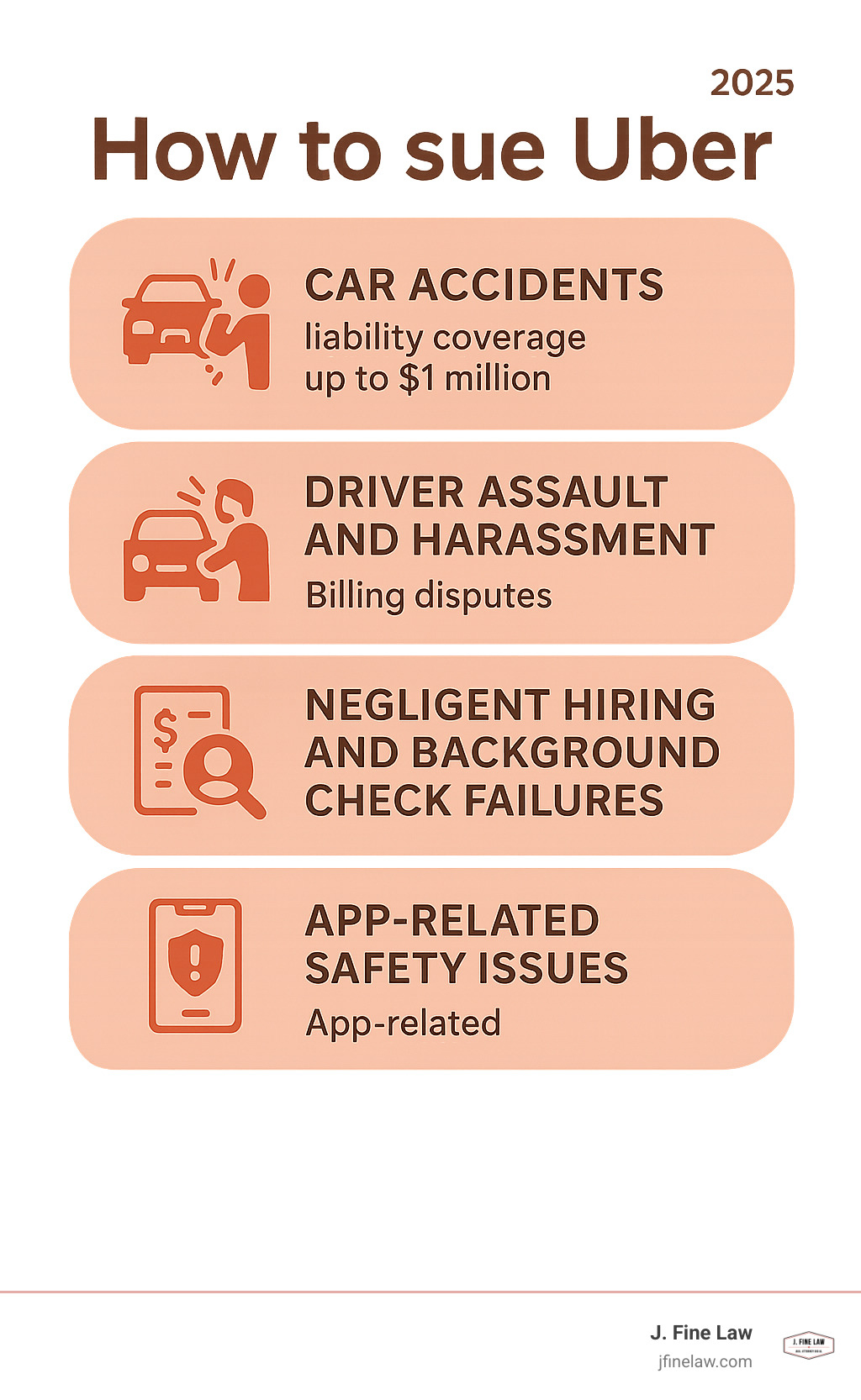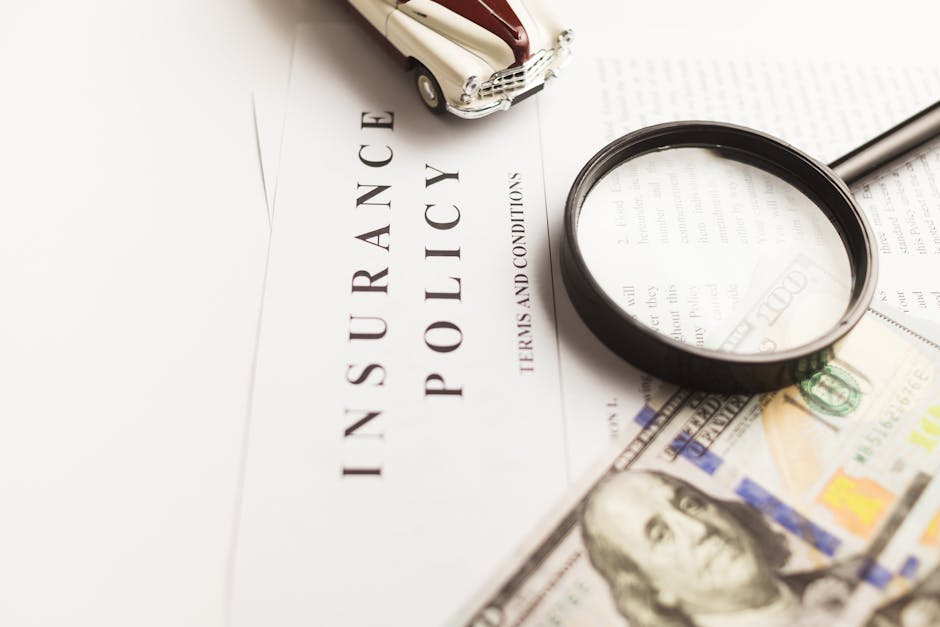When Your Uber Ride Goes Wrong
How to sue Uber starts with understanding your legal options and taking immediate action after an incident. Whether you’ve been injured in an accident, experienced driver misconduct, or faced unfair billing practices, you have several paths to seek compensation:
Quick Answer – How to Sue Uber:
- Document everything – photos, medical records, police reports
- Report the incident to Uber through their app
- Choose your legal avenue:
- Small Claims Court (for damages under $5,000-$10,000)
- Consumer arbitration (often required by Uber’s terms)
- Civil lawsuit (for serious injuries or larger claims)
- Send a demand letter before filing any legal action
- Consult an experienced attorney for complex cases
Rideshare services like Uber have revolutionized transportation, but when things go wrong, passengers often feel powerless against a multi-billion-dollar corporation. The reality is that Uber faces thousands of legal claims each year – from car accidents and driver assault to deceptive billing practices that recently caught the attention of the Federal Trade Commission.
The challenge lies in Uber’s business model. They classify drivers as independent contractors rather than employees, creating a legal barrier between the company and injured parties. Additionally, Uber’s user agreement typically forces disputes into private arbitration rather than traditional courts, limiting your options for seeking justice.
However, you’re not without recourse. Recent studies show that rideshare services may contribute to a 2-3% increase in traffic fatalities since 2011, and courts have established specific circumstances where Uber can be held directly liable for damages – from negligent hiring practices to systemic safety failures.
I’m Jason Fine, a Pennsylvania Super Lawyer with over 25 years of experience representing accident victims, including numerous cases involving how to sue Uber and other rideshare companies. My firm has secured millions in settlements against major corporations, including one of the top motor vehicle verdicts in Pennsylvania where the insurance company initially offered $0.
Understanding Your Legal Options: How to Sue Uber
When you’re up against a corporate giant like Uber, knowing your legal options can feel overwhelming. But here’s the thing – you do have rights, and there are clear paths forward. Let me walk you through exactly when you can sue, what steps to take, and how to steer Uber’s complex insurance system.
Grounds for a Lawsuit: When Can You Sue?
The good news is that people successfully sue Uber every day. While the company tries to shield itself behind legal barriers, there are several solid grounds where you can hold them accountable.
Car accidents represent the most common reason people pursue legal action. If you’re injured as a passenger, another driver, or even a pedestrian in an Uber-related crash, you may have a strong case. This is especially true when the Uber driver’s negligence caused the collision. The numbers are sobering – a University of Chicago study found that rideshare services like Uber are linked to a 2-3% increase in traffic fatalities since 2011.
Driver misconduct cases, while tragic, do happen. If you’ve experienced assault, harassment, or other dangerous behavior from an Uber driver, the company can potentially be held liable. This is particularly true when there’s evidence of negligent hiring – meaning Uber failed to properly screen drivers or ignored red flags in their background checks.
Billing disputes might seem minor compared to physical injuries, but they can add up to significant financial harm. The Federal Trade Commission recently took action against Uber for deceptive practices around their Uber One subscription service. Customers were charged without proper consent, promised savings that didn’t materialize, and faced an incredibly difficult cancellation process involving up to 23 screens and 32 actions! You can read consumer alerts from the FTC to stay informed about these practices.
Legal theories we use to hold Uber accountable include negligent hiring and retention (when they should have known a driver was dangerous), corporate negligence (when Uber’s own policies or technology failures contribute to harm), and in rare cases, vicarious liability (holding them responsible for their drivers’ actions).
The biggest challenge we face is Uber’s independent contractor defense. By classifying drivers as contractors rather than employees, Uber tries to avoid responsibility for their actions. However, this doesn’t make them untouchable – we can still pursue claims based on Uber’s direct negligence and corporate failures.
The First Steps: What to Do Immediately After an Incident
The moments right after an Uber incident are crucial for your case. Think of yourself as gathering evidence for your future self – every photo, every document, every witness contact could make the difference between a successful claim and a denied one.
Safety comes first – always. Call 911 if anyone is injured, and don’t skip medical attention even if you feel fine initially. Injuries like whiplash or internal trauma often don’t show symptoms for hours or days.
Get that police report. This official, unbiased account of what happened becomes invaluable evidence later. While you’re waiting for police, start documenting everything with your phone. Take photos of the accident scene from multiple angles, all vehicle damage, road conditions, traffic signals, and any visible injuries. Get the Uber driver’s information and contact details from any witnesses who saw what happened.
Save your trip details immediately. Screenshot your Uber receipt and trip information before it disappears from the app. Document any communications with the driver or Uber support.
Report to Uber through their app, but be careful with your words. Stick to facts and avoid admitting fault or speculating about what happened.
Understanding what you can claim is important for your case. Economic damages include medical bills, property damage, lost wages, and future earning capacity. Non-economic damages cover pain and suffering, emotional distress, anxiety, and loss of life enjoyment. If you’ve experienced emotional trauma from an Uber incident, this is absolutely recoverable – especially if you were physically impacted or in immediate danger.
For detailed guidance on handling rideshare accidents, you can learn more about Uber and Lyft accidents on our specialized page.
Navigating Uber’s Insurance and Liability
Here’s where things get complicated, but understanding Uber’s insurance system is crucial for how to sue Uber successfully. The coverage depends entirely on what the driver was doing when the incident occurred.
Uber operates a tiered insurance system that changes based on the driver’s status. When the driver is offline with the app turned off, you’re dealing with their personal insurance only – Uber provides zero coverage. This is why determining the driver’s status at the time of your incident is absolutely critical.
When a driver is online but waiting for a ride request, Uber provides limited backup coverage. This kicks in if the driver’s personal insurance won’t cover commercial activities – which most personal policies won’t.
The real coverage comes during active rides. From the moment a driver accepts your ride request until you’re dropped off, Uber maintains up to $1 million in liability coverage. This substantial policy is designed to protect passengers, other drivers, and pedestrians when accidents happen during active trips.
Determining liability can involve multiple parties. The Uber driver bears primary responsibility if their negligence caused the accident. Uber Technologies, Inc. can be held liable when we prove their direct negligence – whether through inadequate background checks, dangerous corporate policies, or technology failures that contributed to the incident.
Sometimes other drivers, vehicle manufacturers, or even local municipalities share responsibility depending on the circumstances. Our job is identifying every potentially liable party to maximize your compensation.
Legal Avenues: How to Sue Uber for Compensation
Once you understand your situation and have documented everything, you need to choose the right legal path. Uber makes this challenging by requiring most disputes to go through arbitration rather than traditional courts – this clause is buried in their user agreement that most people never read.
But don’t let arbitration clauses discourage you. You still have several options for pursuing compensation:
Small Claims Court works for smaller damages (typically under $5,000-$10,000 depending on your state). It’s faster and less expensive than traditional litigation, but you’re limited in how much you can recover. Consumer arbitration is often required by Uber’s terms, but it can still result in substantial awards, especially for serious injuries. Civil lawsuits remain possible in many cases, particularly when you can prove Uber’s direct corporate negligence.
The key is sending a demand letter before filing any legal action. This formal notice puts Uber on notice of your claim and often leads to settlement negotiations without the need for lengthy court proceedings.
For complex cases involving serious injuries or significant damages, hiring an experienced attorney becomes essential. Uber has teams of lawyers working to minimize their liability – you need someone equally skilled fighting for your rights. Our Philadelphia rideshare accident lawyers have the experience and resources to take on corporate giants like Uber.
A Closer Look: How to Sue Uber in Small Claims Court
Small claims court can be an effective option for straightforward cases with limited damages. Each state sets its own monetary limits – you can find your state’s small claims limits here to see if this option works for your situation.
The process is relatively straightforward but requires attention to detail. You’ll start by sending a demand letter to Uber explaining your claim and requesting compensation. If they don’t respond satisfactorily, you’ll file the necessary court forms and arrange for Uber to be properly served with the lawsuit.
Pros of small claims court include lower costs, faster resolution, and less formal procedures that don’t require an attorney. Cons include limited damage awards, no possibility of punitive damages, and the challenge of collecting even if you win.
The reality is that while small claims court works for minor property damage or small billing disputes, most serious Uber incidents involve damages that exceed small claims limits. That’s when you need the full power of traditional litigation to get the compensation you deserve.



